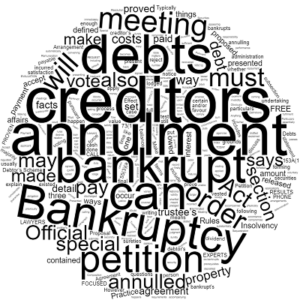Table of Contents
Toggle Bankruptcy annulment happens in one of three ways.
Bankruptcy annulment happens in one of three ways.
The first way for bankruptcy annulment is to pay all of your debts.
The second way for the annulment of the bankruptcy is to compromise the debts with a creditors’ agreement.
The final way is to apply to the Court for an order annulling the bankruptcy.
Bankruptcy annulment essentially puts the bankrupt back in the position they were before the bankruptcy.
Any property of the bankrupt which vests in the trustee will again vest in the now ex-bankrupt person.
Our bankruptcy lawyers will explain bankruptcy annulment in more detail below.
Bankruptcy Annulment
As previously stated, a bankruptcy can be annulled in one (1) of three (3) ways:
- The bankrupt pays all of his/her debts;
- Compromise the debts with a creditors’ agreement; and
- Make a bankruptcy annulment application in Court.
We will discuss these in more detail below.
The Bankrupt Pays all of His / Her Debts
The bankruptcy will be annulled if the trustee is satisfied that all of the bankrupts’ debts proved in the bankruptcy have been paid in full.
Section 153A(1) of the Bankruptcy Act says:
If the trustee is satisfied that all the bankrupt’s debts have been paid in full, the bankruptcy is annulled, by force of this subsection, on the date on which the last such payment was made.
This also includes any interest on those debts, and costs expenses and any charges on those debts or incurred by the trustee during the administration of the bankruptcy.
This will usually occur when the debtor did not have the means to raise sufficient cash to pay debts but had enough assets when realised and sold to pay the debts.
This is called the “cash flow test” and the “balance sheet test”.
However the debts get paid, the bankruptcy annulment will occur upon payment of the final debt.
Payment of the Trustee’s Remuneration
To annul the bankruptcy in this way the bankrupt must also pay the costs expenses and any charges incurred by the trustee, and also the trustee’s remuneration.
Section 153A(1) of the Bankruptcy Act says:
“bankrupt’s debts” means all debts that have been proved in the bankruptcy and includes interest payable on such of those debts as bear interest, and the costs, charges and expenses of the administration of the bankruptcy, including the remuneration and expenses of the trustee.
This can be considerable, but the trustee’s remuneration must be agreed before the annulment can occur.
If the bankrupt is unable to pay all of his / her debts, then the bankrupt can propose a scheme of arrangement or composition.
Compromise the Debts with a Creditors’ Agreement
Bankruptcy annulment can also happen if the bankrupt proposes a scheme of arrangement or composition, which is passed by a special resolution of the bankrupts’ creditors.
Section 73(1) of the Bankruptcy Act says:
Where a bankrupt desires to make a proposal to his or her creditors for:
(a) a composition in satisfaction of his or her debts; or
(b) a scheme of arrangement of his or her affairs;
he or she may lodge with the trustee a proposal in writing signed by him or her setting out the terms of the proposed composition or scheme of arrangement and particulars of any sureties or securities forming part of the proposal.
Then, section 74(1) of the Bankruptcy Act says:
If the proposal is accepted by a special resolution of creditors at a meeting held in accordance with the Insolvency Practice Rules, the bankruptcy is annulled, by force of this subsection, on the day the special resolution was passed.
Ok, so what does that all mean?
Definitions of the Words
Composition is defined as – A legal agreement to pay an amount of money in lieu of a larger debt or other obligation. Basically, an arrangement for a lesser sum than the amount owed.
Scheme of Arrangement – is a voluntary agreement between a bankrupt and his / her creditors in satisfaction of the debts.
Special Resolution – is a resolution put to creditors in a meeting and is passed.
Sureties are defined as – A person who takes responsibility for another’s performance of an undertaking, for example their appearing in court or the payment of a debt.
Securities are defined as – things deposited or pledged as a guarantee of the fulfilment of an undertaking or the repayment of a loan, to be forfeited in case of default.
The Process of Making the Agreement
To enter into a scheme of arrangement or composition, there must be the following:
- A proposal to the creditors;
- A meeting of the creditors; and
- The creditors must accept the proposal by special resolution.
We will explain the process in more detail below.
A Proposal to the Creditors
A section 73 bankruptcy annulment proposal must be lodged in writing with the trustee.
Pursuant to section 73(1) above it must set out the terms of the proposed composition or scheme of arrangement and any particulars of any sureties or securities.
The proposal should include the following information:
- Where the funds are coming from;
- Particulars of any surety or security; and
- An estimate of the amount of dividend that may be payable;
Once drafted and lodged with the trustee, the trustee must call a meeting of creditors.
The Insolvency Practice Rules (Bankruptcy) 2016 sets out the rules for calling creditor’s meetings.
Section 73 Bankruptcy Annulment Meeting of the Creditors
Only creditors who have proved their debts can vote at the creditors meeting.
At the meeting of creditors, each of the creditors can vote by giving a written notice to the trustee before the meeting, and do not have to be physically present.
The trustee can prompt questions and invite questions from any creditors present.
It is then put to a vote and a determination is made whether to accept or reject the proposal.
The Creditors must Accept the Proposal
The special resolution is passed at the section 73 bankruptcy annulment creditors meeting if the majority of creditors vote to accept it; and also 75% of the total value of the creditors vote for the section 73 bankruptcy annulment proposal.
Section 75-132 of the Practice Rules (Bankruptcy) 2016 says:
A special resolution is passed at a meeting of creditors of a regulated debtor if:
(a) a majority of the creditors voting at the meeting vote in favour of the resolution; and
(b) at least 75% in value of the creditors voting at the meeting vote in favour of the resolution; and
(c) if the resolution relates to paragraph 109(1)(j) of the Act — the notice convening the meeting at which the resolution was passed contained a copy of the proposed resolution.
If the above does not happen, then the special resolution is not passed.
If the special resolution is passed then the bankruptcy is annulled immediately automatically, and the trustee must inform the Official Receiver.
The Effect of the Scheme of Arrangement
If the resolution passes, then it is binding on all creditors of the bankrupt.
All proved debts are then released at whatever dividend return the creditors voted for pursuant to the scheme of arrangement.
However, the debtor / ex-bankrupt is not released from certain debts if they would not be released from if the bankruptcy were discharged.
The scheme of arrangement can also be varied, set aside and/or terminated in certain circumstances.
If the resolution does not pass, then a bankrupt can apply to the Court for annulment of bankruptcy.
Make a Bankruptcy Annulment Application in Court
There are three (3) grounds that a Court will consider in a bankruptcy annulment application. These grounds are if the Court is satisfied that:
- A sequestration order ought not to have been made; or
- A debtor’s petition ought not to have been presented; or
- A debtor’s petition ought not to have been accepted by the Official Receiver.
This is pursuant to section 153B of the Bankruptcy Act says:
If the Court is satisfied that a sequestration order ought not to have been made or, in the case of a debtor’s petition, that the petition ought not to have been presented or ought not to have been accepted by the Official Receiver, the Court may make an order annulling the bankruptcy.
If the bankrupt manages to persuade the Court that one of the above occurred, then the Court may make an annulment of bankruptcy order
Again, these will be explained in more detail below.
A Sequestration Order Ought not to have been Made
If a bankrupt can prove in the bankruptcy annulment application that there existed at the time of the sequestration order, a set of facts which had the Court known about, would not have made the sequestration order.
Typically, these facts are things like:
- Non-service or incorrect of the creditor’s petition;
- The debt was not owed by the bankrupt;
- The debt had been paid by the bankrupt;
- The invalidity of the judgment forming the basis of the bankruptcy; and/or
- The bankrupt is denied natural justice;
Obviously, the onus of proving these matters falls on the applicant.
The Court must determine firstly if the sequestration order should have been made, and then secondly exercise its discretion whether to make the annulment of bankruptcy order.
In Barnes v Lion Finance Pty Ltd [2015] FCA 951 at [22], Beach J summarised the position in relation to the exercise of the discretion under s 153B(1):
…as to the phrase “ought not to have been made”, the question is whether on the facts at the time, now known to have existed at the time, the court making the sequestration order would have been bound not to make the sequestration order. The test is not whether such a court might not have made the order or that it was likely that the court would not have made the order. The question is whether that court was bound not to make the order. Fourth, even if the condition is satisfied, nevertheless the Court may still refuse to exercise its discretion to annul. In the exercise of its discretion, the Court may consider:
whether the applicant is solvent at the time of the annulment application;
whether the applicant has made full disclosure of his financial affairs;
any failure by the applicant to attend the hearing concerning the making of the sequestration order or to oppose such an order, and the explanation for such conduct;
any failure by the applicant to put before the earlier court facts then known to the applicant and the explanation for that failure;
whether the applicant has delayed in making the annulment application and the time that has elapsed since the making of the sequestration order;
the preparedness of the applicant to pay the costs thrown away by reason of the annulment application and the trustee’s costs and expenses of the bankruptcy to the extent that they have not otherwise been recovered from the bankrupt’s estate;
the rights and interests of the creditors, including the applicant’s preparedness to pay any outstanding debts as an alternative arrangement to the continuation of the bankruptcy;
the conduct of the applicant during the period of the bankruptcy, including the applicant’s co-operation with the trustee and also whether there has been any conduct that may give rise to bankruptcy offences;
the steps taken by the trustee to investigate and realise the estate and whether there has been any impediment due to the conduct of the applicant or a third party;
whether it is fair or just to the applicant or the creditors to grant the annulment;
the public interest…
If the debtor became bankrupt by way of a debtor’s petition, then the Court may also make an annulment of bankruptcy order if the petition ought not to have been presented.
A Debtor’s Petition Ought not to have been Presented
If a bankrupt can prove in a bankruptcy annulment application that there existed at the time of presenting the debtor’s petition, a set of facts which would have meant that the petition would not have been accepted.
Typically, these facts in these bankruptcy annulment applications are things like:
- An abuse of process;
- The debtor was not insolvent; or
- The Court is satisfied that the debtor can make arrangements to pay creditors.
A bankruptcy can also be annulled if the debtor’s petition ought not to have been accepted by the Official Receiver.
A Debtor’s Petition Ought not to have been Accepted
These bankruptcy annulment application cases are usually limited to where the Official Receiver accepted a debtors petition where the prerequisites contained at 55(3)(a) of the Bankruptcy Act had not been met.
Section 55(3)(a) of the Bankruptcy Act says:
(3) The Official Receiver may reject a debtor’s petition if:
(a) the petition does not comply substantially with the approved form; or
(b) the petition is not accompanied by a statement of affairs; or
(c) the Official Receiver thinks that the statement of affairs accompanying the petition is inadequate.
If the Official Receiver accepted it when it should not have, then an annulment of bankruptcy order can be made.
What is the Effect of Bankruptcy Annulment?
There are a number of effects on the annulment of the bankruptcy which are contained at section 154 of the Bankruptcy Act. In relation to any property, they include:
- Anything duly done by the trustee before annulment is validly done;
- Any property vesting in the trustee can be applied to costs, charges, expenses, and the trustee’s remuneration;
- If there is a shortfall in vested property and it is not enough to pay the costs, charges, expenses, and the trustee’s remuneration, then the balance becomes a debt owed by the ex-bankrupt to the trustee, and may be recovered in Court; and
- The remainder of that property still vested in the trustee reverts to the bankrupt.
If the annulment is given, then an ex-bankrupts name will stay on the National Personal Insolvency Index (“NPII”) with the bankruptcy listed as “annulled”.
Credit reporting agencies will keep a record of this for a further seven (7) years.
An ex-bankrupt may still be liable for any debts not covered by bankruptcy.
Bankruptcy Annulment Lawyers
As you can see, there is a few ways in which a bankruptcy can be annulled, and you will need advice from a bankruptcy lawyer.
If you think that you can satisfy the requirements above, then you should contact a bankruptcy lawyer as soon as possible to discuss your proposal.
FOCUSED LAWYERS – BANKRUPTCY EXPERTS – PROVEN RESULTS
OR CALL: 1300 545 133 FOR A FREE PHONE CONSULTATION








